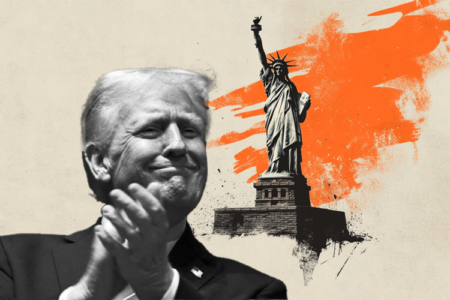- The US Dollar is dipping, with the DXY US Dollar Index down by around 0.60%.
- China says tariffs need to go first, before talks can start.
- The US Dollar Index remains capped below the 100.00 round level.
The US Dollar Index (DXY), which tracks the performance of the US Dollar (USD) against six major currencies, trades lower, roughly 0.60% at the start of the US trading session on Thursday. The knee-jerk reaction comes after comments from United States (US) President Donald Trump and US Treasury Secretary Scott Bessent. Both individually said that no unilateral offer was made to China from the US to lower tariffs, while Trump said that reciprocal tariffs could be revisited if negotiations are not going the way the Trump administration wants them to go, Bloomberg reports.
On the economic calendar front, a very intensive trading day is ahead. Besides the weekly Jobless Claims, both the Chicago Fed Activity Tracker and the Kansas Fed Manufacturing Index are due to be released. The main focus, however, will likely be on the Durable Goods Orders data for March, with markets expecting orders to increase at a faster pace of 2%.
Daily digest market movers: China issues reply
- The Financial Times reports that China has called on the US to “completely cancel all unilateral tariff measures” if it wants trade talks on Thursday just hours before the US opening bell. Previous remarks and statements from the Trump administration on a possible trade deal with China are being labeled as ‘fake news’ by Beijing.
- At 12:30 GMT, the Chicago Fed National Activity Index for March is due. No forecast available, and the previous reading came in at 0.18.
- At the same time, the US Durable Goods for March and the Jobless Claims are due:
-
- Headline Durable Goods are expected to jump to 2% from 1% previously. The Orders without Cars and Transportation are expected to increase by 0.2%, less than the 0.7% advance seen a month earlier.
- Weekly Initial Jobless Claims are expected to tick higher to 221,000 from 215,000. Continuing Claims are expected to remain stable at around 1.88 million.
- Around 14:00 GMT, Existing Home Sales data for March will be published. Sales are expected to soften to 4.13 million against 4.26 million in February.
- Near 15:00 GMT, the Kansas Fed Manufacturing Activity Index for April is expected. No forecast available with the previous number at 1.
- Equities look bleak this Thursday, with minor losses in Europe. US futures are facing over 0.30% declines.
- The CME FedWatch tool shows the chance of an interest rate cut by the Federal Reserve in May’s meeting stands at 6.1% against a 93.9% probability of no change. The June meeting still has around a 58.7% chance of a rate cut.
- The US 10-year yields trade around 4.33% looking for direction as markets are facing some knee jerk reactions on the Trump comments.
US Dollar Index Technical Analysis: Headline risks and volatility
The US Dollar Index (DXY) is backing off again after a two-day recovery. It looks like the DXY will start to consolidate, trading in a tight range between 100.00 and 98.00. Traders are likely to be fed up with these constant knee-jerk reactions and could opt to look for other places to put their money, with Gold as the preferred sweet spot.
On the upside, the DXY’s first resistance comes in at 99.58, acting up again as a false break occurred Wednesday and Thursday. Should the US Dollar be able to turn positive again, look for 100.22 with a break back above the 100.00 round level as a bullish signal of their return. A firm recovery would be a return to 101.90.
On the other hand, the 97.73 support is very close and could snap at any moment. Further below, a rather thin technical support comes in at 96.94, before looking at the lower levels of this new price range. These would be at 95.25 and 94.56, meaning fresh lows not seen since 2022.
US Dollar Index: Daily Chart
US Dollar FAQs
The US Dollar (USD) is the official currency of the United States of America, and the ‘de facto’ currency of a significant number of other countries where it is found in circulation alongside local notes. It is the most heavily traded currency in the world, accounting for over 88% of all global foreign exchange turnover, or an average of $6.6 trillion in transactions per day, according to data from 2022.
Following the second world war, the USD took over from the British Pound as the world’s reserve currency. For most of its history, the US Dollar was backed by Gold, until the Bretton Woods Agreement in 1971 when the Gold Standard went away.
The most important single factor impacting on the value of the US Dollar is monetary policy, which is shaped by the Federal Reserve (Fed). The Fed has two mandates: to achieve price stability (control inflation) and foster full employment. Its primary tool to achieve these two goals is by adjusting interest rates.
When prices are rising too quickly and inflation is above the Fed’s 2% target, the Fed will raise rates, which helps the USD value. When inflation falls below 2% or the Unemployment Rate is too high, the Fed may lower interest rates, which weighs on the Greenback.
In extreme situations, the Federal Reserve can also print more Dollars and enact quantitative easing (QE). QE is the process by which the Fed substantially increases the flow of credit in a stuck financial system.
It is a non-standard policy measure used when credit has dried up because banks will not lend to each other (out of the fear of counterparty default). It is a last resort when simply lowering interest rates is unlikely to achieve the necessary result. It was the Fed’s weapon of choice to combat the credit crunch that occurred during the Great Financial Crisis in 2008. It involves the Fed printing more Dollars and using them to buy US government bonds predominantly from financial institutions. QE usually leads to a weaker US Dollar.
Quantitative tightening (QT) is the reverse process whereby the Federal Reserve stops buying bonds from financial institutions and does not reinvest the principal from the bonds it holds maturing in new purchases. It is usually positive for the US Dollar.
Read the full article here
















